Research Progress of Taste Biosensors in Simulating Taste Transduction Mechanism
Abstract
1. Introduction
2. Biorecognition Elements Based Taste-Biosensors
2.1. Receptor-Based Taste Biosensors
2.2. Cell-Based Taste Biosensors
2.3. Tissue-Based and MGS-Based Taste Biosensors
3. Analysis of Signals from Taste Biosensors
3.1. Low-Dimensional Signal from Taste Sensors Using Taste Receptors and Cells
3.2. High-Dimensional Signal from Taste Sensors Using Taste Epithelium or MGS
4. Conclusions and Prospect
Author Contributions
Funding
Institutional Review Board Statement
Informed Consent Statement
Data Availability Statement
Acknowledgments
Conflicts of Interest
References
- Hayashi, N.; Chen, R.; Ikezaki, H.; Yamaguchi, S.; Maruyama, D.; Yamaguchi, Y.; Ujihara, T.; Kohata, K. Techniques for universal evaluation of astringency of green tea infusion by the use of a taste sensor system. Biosci. Biotech. Bioch. 2006, 70, 626–631. [Google Scholar] [CrossRef] [PubMed]
- Toko, K.; Tahara, Y.; Habara, M.; Kobayashi, Y.; Ikezaki, H. Taste Sensor. In Essentials of Machine Olfaction and Taste, 4th ed.; Nakamoto, T., Ed.; Wiley: Hoboken, NJ, USA, 2016; pp. 87–174. ISBN 9781118768495. [Google Scholar]
- Wu, X.; Tahara, Y.; Yatabe, R.; Toko, K. Taste sensor: Electronic tongue with lipid membranes. Anal. Sci. 2020, 36, 147–159. [Google Scholar] [CrossRef] [PubMed]
- Toko, K.; Akiyama, H.; Chishaki, K.; Ezaki, S.; Iyota, T.; Yamafuji, K. Detection of taste substances using impedance change in lipid/polymer membranes. Sens. Mater. 1997, 9, 321–329. [Google Scholar]
- Hao, M.; Li, Z.; Huang, X.; Wang, Y.; Wei, X.; Zou, X.; Shi, J.; Huang, Z.; Yin, L.; Gao, L. A cell-based electrochemical taste sensor for detection of Hydroxy-α-sanshool. Food Chem. 2023, 418, 135941. [Google Scholar] [CrossRef] [PubMed]
- Du, L.; Chen, W.; Tian, Y.; Zhu, P.; Wu, C.; Wang, P. A biomimetic taste biosensor based on bitter receptors synthesized and purified on chip from a cell-free expression system. Sens. Actuators B 2020, 312, 127949. [Google Scholar] [CrossRef]
- Qiao, L.; Jiao, L.; Pang, G.; Xie, J. A novel pungency biosensor prepared with fixing taste-bud tissue of rats. Biosens. Bioelectron. 2015, 68, 454–461. [Google Scholar] [CrossRef]
- Morales, M.A.; Halpern, J.M. Guide to selecting a biorecognition element for biosensors. Bioconjugate Chem. 2018, 29, 3231–3239. [Google Scholar] [CrossRef]
- Chambers, J.P.; Arulanandam, B.P.; Matta, L.L.; Weis, A.; Valdes, J.J. Biosensor recognition elements. Curr. Issues Mol. Biol. 2008, 10, 1–12. [Google Scholar] [CrossRef]
- Zheng, W.; Xia, X.; Shi, Y.; Men, H. CMTP-TCE: A Data Augmentation Method of Electronic Tongue Combined with Dot-Product Attention Mechanism and Residual Network for Food Quality Classification. IEEE Sens. J. 2023, 23, 21652–21660. [Google Scholar] [CrossRef]
- Roper, S.D. Encoding Taste: From Receptors to Perception. In The Pharmacology of Taste; Palmer, R.K., Servant, G., Eds.; Springer International Publishing: Cham, Germany, 2022; pp. 53–90. ISBN 978-3-031-06450-0. [Google Scholar]
- Lindemann, B. Receptors and transduction in taste. Nature 2001, 413, 219–225. [Google Scholar] [CrossRef]
- Crouzet, S.M.; Busch, N.A.; Ohla, K. Taste quality decoding parallels taste sensations. Curr. Biol. 2015, 25, 890–896. [Google Scholar] [CrossRef] [PubMed]
- Roper, S.D.; Chaudhari, N. Taste buds: Cells, signals and synapses. Nat. Rev. Neurosci. 2017, 18, 485–497. [Google Scholar] [CrossRef] [PubMed]
- Hurot, C.; Brenet, S.; Buhot, A.; Barou, E.; Belloir, C.; Briand, L.; Hou, Y. Highly sensitive olfactory biosensors for the detection of volatile organic compounds by surface plasmon resonance imaging. Biosens. Bioelectron. 2019, 123, 230–236. [Google Scholar] [CrossRef] [PubMed]
- Rizzotto, F.; Khalife, M.; Hou, Y.; Chaix, C.; Lagarde, F.; Scaramozzino, N.; Vidic, J. Recent advances in electrochemical biosensors for food control. Micromachines 2023, 14, 1412. [Google Scholar] [CrossRef] [PubMed]
- Herness, M.S.; Gilbertson, T.A. Cellular mechanisms of taste transduction. Annu. Rev. Physiol. 1999, 61, 873–900. [Google Scholar] [CrossRef] [PubMed]
- Chandrashekar, J.; Hoon, M.A.; Ryba, N.J.; Zuker, C.S. The receptors and cells for mammalian taste. Nature 2006, 444, 288–294. [Google Scholar] [CrossRef]
- Clapp, T.R.; Stone, L.M.; Margolskee, R.F.; Kinnamon, S.C. Immunocytochemical evidence for co-expression of Type III IP 3 receptor with signaling components of bitter taste transduction. BMC Neurosci. 2001, 2, 6. [Google Scholar] [CrossRef]
- Ishimaru, Y.; Matsunami, H. Transient receptor potential (TRP) channels and taste sensation. J. Dent. Res. 2009, 88, 212–218. [Google Scholar] [CrossRef]
- Iannilli, E.; Gudziol, V. Gustatory pathway in humans: A review of models of taste perception and their potential lateralization. J. Neurosci. Res. 2019, 97, 230–240. [Google Scholar] [CrossRef]
- Liu, J.; Zhang, N.; Li, J.; Li, M.; Wang, G.; Wang, W.; Fan, Y.; Jiang, S.; Chen, G.; Zhang, Y. A novel umami electrochemical biosensor based on AuNPs@ ZIF-8/Ti3C2 MXene immobilized T1R1-VFT. Food Chem. 2022, 397, 133838. [Google Scholar] [CrossRef]
- Song, H.S.; Kwon, O.S.; Lee, S.H.; Park, S.J.; Kim, U.K.; Jang, J.; Park, T.H. Human Taste Receptor-Functionalized Field Effect Transistor as a Human-Like Nanobioelectronic Tongue. Nano Lett. 2013, 13, 172–178. [Google Scholar] [CrossRef] [PubMed]
- Han, J.-K.; Park, S.-C.; Yu, J.-M.; Ahn, J.-H.; Choi, Y.-K. A bioinspired artificial gustatory neuron for a neuromorphic based electronic tongue. Nano Lett. 2022, 22, 5244–5251. [Google Scholar] [CrossRef] [PubMed]
- Liu, J.; Cha, Y.K.; Choi, Y.; Lee, S.-E.; Wang, G.; Zhao, S.; Park, T.H.; Liu, Y.; Hong, S. Hydrogel-based Bioelectronic Tongue for the Evaluation of Umami Taste in Fermented Fish. ACS Sens. 2023, 8, 2750–2760. [Google Scholar] [CrossRef] [PubMed]
- Jeong, J.-Y.; Cha, Y.K.; Ahn, S.R.; Shin, J.; Choi, Y.; Park, T.H.; Hong, S. Ultrasensitive bioelectronic tongue based on the Venus flytrap domain of a human sweet taste receptor. ACS Appl. Mater. Interfaces 2022, 14, 2478–2487. [Google Scholar] [CrossRef]
- del Valle, M. Electronic tongues employing electrochemical sensors. Electroanalysis 2010, 22, 1539–1555. [Google Scholar] [CrossRef]
- Stefan, R.-I.; Staden, J.F.v.; Aboul-Enein, H.Y. Electrochemical sensor arrays. Crit. Rev. Anal. Chem. 1999, 29, 133–153. [Google Scholar] [CrossRef]
- Wang, P.; Ye, X.; Liu, J.; Xiao, Y.; Tan, M.; Deng, Y.; Yuan, M.; Luo, X.; Zhang, D.; Xie, X. Recent advancements in the taste transduction mechanism, identification, and characterization of taste components. Food Chem. 2023, 433, 137282. [Google Scholar] [CrossRef]
- Chale-Rush, A.; Burgess, J.R.; Mattes, R.D. Evidence for human orosensory (taste?) sensitivity to free fatty acids. Chem. Senses 2007, 32, 423–431. [Google Scholar] [CrossRef]
- Dutta Banik, D.; Medler, K.F. Taste Receptor Signaling. In The Pharmacology of Taste; Palmer, R.K., Servant, G., Eds.; Springer International Publishing: Cham, Germany, 2022; pp. 33–52. ISBN 978-3-031-06450-0. [Google Scholar]
- Davies, R.O.; Kare, M.R.; Cagan, R.H. Distribution of taste buds on fungiform and circumvallate papillae of bovine tongue. Anat. Rec. 1979, 195, 443–446. [Google Scholar] [CrossRef]
- Adler, E.; Hoon, M.A.; Mueller, K.L.; Chandrashekar, J.; Ryba, N.J.; Zuker, C.S. A novel family of mammalian taste receptors. Cell 2000, 100, 693–702. [Google Scholar] [CrossRef]
- Fukuda, S.; Murabe, N.; Mizuta, H.; Yamamoto, T.; Nagai, T. Bioelectrical signal associated with sweet taste transduction in humans is a hyperpolarizing potential on the lingual epithelium. Chem. Senses 2021, 46, bjab040. [Google Scholar] [CrossRef]
- Li, X.; Staszewski, L.; Xu, H.; Durick, K.; Zoller, M.; Adler, E. Human receptors for sweet and umami taste. Proc. Natl. Acad. Sci. USA 2002, 99, 4692–4696. [Google Scholar] [CrossRef] [PubMed]
- Pin, J.-P.; Galvez, T.; Prézeau, L. Evolution, structure, and activation mechanism of family 3/C G-protein-coupled receptors. Pharmacol. Ther. 2003, 98, 325–354. [Google Scholar] [CrossRef] [PubMed]
- Ren, S.; Hu, P.; Jia, J.; Ni, J.; Jiang, T.; Yang, H.; Bai, J.; Tian, C.; Chen, L.; Huang, Q. Engineering of Saccharomyces cerevisiae for sensing sweetness. Biochem. Eng. J. 2022, 177, 108239. [Google Scholar] [CrossRef]
- Kikut-Ligaj, D.; Trzcielińska-Lorych, J. How taste works: Cells, receptors and gustatory perception. Cell. Mol. Biol. Lett. 2015, 20, 699–716. [Google Scholar] [CrossRef] [PubMed]
- Shen, J.-k.; Zhang, H.-t. Function and structure of bradykinin receptor 2 for drug discovery. Acta Pharmacol. Sin. 2023, 44, 489–498. [Google Scholar] [CrossRef]
- Khan, A.; Ahmed, S.; Sun, B.-Y.; Chen, Y.-C.; Chuang, W.-T.; Chan, Y.-H.; Gupta, D.; Wu, P.-W.; Lin, H.-C. Self-healable and anti-freezing ion conducting hydrogel-based artificial bioelectronic tongue sensing toward astringent and bitter tastes. Biosens. Bioelectron. 2022, 198, 113811. [Google Scholar] [CrossRef]
- Kim, M.; Kim, H.; Park, T.; Ahn, B.J.; Lee, S.; Lee, M.; hun Lee, J.; Oh, U.; Jang, Y. Rapid quantitative analysis of tobacco smoking in saliva using a TRPA1 ion channel-mediated bioelectronic tongue inspired by the human sensory system. Sens. Actuators B 2023, 393, 134149. [Google Scholar] [CrossRef]
- Moon, D.; Cha, Y.K.; Kim, S.-o.; Cho, S.; Ko, H.J.; Park, T.H. FET-based nanobiosensors for the detection of smell and taste. Sci. China Life Sci. 2020, 63, 1159–1167. [Google Scholar] [CrossRef]
- Magar, H.S.; Hassan, R.Y.; Mulchandani, A. Electrochemical impedance spectroscopy (EIS): Principles, construction, and biosensing applications. Sensors 2021, 21, 6578. [Google Scholar] [CrossRef]
- Manceau, M.; Farre, C.; Lagarde, F.; Mathey, R.; Buhot, A.; Vidic, J.; Léguillier, V.; Hou, Y.; Chaix, C. Investigation of the Affinity of Aptamers for Bacteria by Surface Plasmon Resonance Imaging Using Nanosomes. ACS Appl. Mater. Interfaces 2024, 16, 29645–29656. [Google Scholar] [CrossRef] [PubMed]
- Rich, R.L.; Myszka, D.G. Advances in surface plasmon resonance biosensor analysis. Curr. Opin. Biotechnol. 2000, 11, 54–61. [Google Scholar] [CrossRef] [PubMed]
- Li, M.; Zhang, N.; Cui, Z.; Wang, W.; Wang, C.; Wang, D.; Li, M.; Lu, W.; Qing, G.; Liu, Y. Biomimetic ion nanochannels for sensing umami substances. Biomaterials 2022, 282, 121418. [Google Scholar] [CrossRef] [PubMed]
- Yu, Y.; Jiang, S.; Cui, Z.; Zhang, N.; Li, M.; Liu, J.; Meng, H.; Wang, S.; Zhang, Y.; Han, J. Bimetallic bionic taste sensor for perception of the synergistic effect of umami substances. Biosens. Bioelectron. 2023, 234, 115357. [Google Scholar] [CrossRef] [PubMed]
- Choi, Y.; Lee, S.; Lee, S.; Hong, S.; Kwon, H.W. Bioelectronic Tongues Mimicking Insect Taste Systems for Real-Time Discrimination between Natural and Artificial Sweeteners. ACS Sens. 2022, 7, 3682–3691. [Google Scholar] [CrossRef] [PubMed]
- Hwang, J.Y.; Kim, K.H.; Seo, S.E.; Nam, Y.; Jwa, S.; Yang, I.; Park, T.H.; Kwon, O.S.; Lee, S.H. Bioelectronic Tongue for Identifying and Masking Bitterness Based on Bitter Taste Receptor Agonism and Antagonism. Adv. Funct. Mater. 2023, 33, 2304997. [Google Scholar] [CrossRef]
- Li, J.; Wang, W.; Liu, J.; Li, H.; Zhang, N.; Yang, F.; Dong, H.; Sun, X.; Chen, G.; Fan, Y. Human-like performance umami electrochemical biosensor by utilizing co-electrodeposition of ligand binding domain T1R1-VFT and Prussian blue. Biosens. Bioelectron. 2021, 193, 113627. [Google Scholar] [CrossRef]
- Wang, Y.; Kong, L.; Shu, G.; Sun, G.; Feng, Y.; Zhu, M. Development of sensitive and stable electrochemical impedimetric biosensor based on T1R1 receptor and its application to detection of umami substances. Food Chem. 2023, 423, 136233. [Google Scholar] [CrossRef]
- Chen, W.; Huang, Y.; Jiang, S.; Chen, G.; Liu, Y. Research on sensing characteristics of three human umami receptors via receptor-based biosensor. Flavour Fragr. J. 2020, 35, 695–702. [Google Scholar] [CrossRef]
- Chaudhari, N.; Landin, A.M.; Roper, S.D. A metabotropic glutamate receptor variant functions as a taste receptor. Nat. Neurosci. 2000, 3, 113–119. [Google Scholar] [CrossRef]
- D’Urso, O.; Drago, F. Pharmacological significance of extra-oral taste receptors. Eur. J. Pharmacol. 2021, 910, 174480. [Google Scholar] [CrossRef] [PubMed]
- Zhang, W.; Chen, P.; Zhou, L.; Qin, Z.; Gao, K.; Yao, J.; Li, C.; Wang, P. A biomimetic bioelectronic tongue: A switch for On-and Off-response of acid sensations. Biosens. Bioelectron. 2017, 92, 523–528. [Google Scholar] [CrossRef] [PubMed]
- Chaudhari, N.; Roper, S.D. Review series: The cell biology of taste. J. Cell Biol. 2010, 190, 285. [Google Scholar] [CrossRef] [PubMed]
- Ramsey, I.S.; DeSimone, J.A. Otopetrin-1: A sour-tasting proton channel. J. Gen. Physiol. 2018, 150, 379–382. [Google Scholar] [CrossRef] [PubMed]
- Taruno, A.; Vingtdeux, V.; Ohmoto, M.; Ma, Z.; Dvoryanchikov, G.; Li, A.; Adrien, L.; Zhao, H.; Leung, S.; Abernethy, M. CALHM1 ion channel mediates purinergic neurotransmission of sweet, bitter and umami tastes. Nature 2013, 495, 223–226. [Google Scholar] [CrossRef] [PubMed]
- Ye, J.; Fan, M.; Zhang, X.; Liang, Q.; Zhang, Y.; Zhao, X.; Lin, C.-T.; Zhang, D. A novel biomimetic electrochemical taste-biosensor based on conformational changes of the taste receptor. Biosens. Bioelectron. 2024, 249, 116001. [Google Scholar] [CrossRef]
- Kwon, O.S.; Song, H.S.; Park, T.H.; Jang, J. Conducting nanomaterial sensor using natural receptors. Chem. Rev. 2018, 119, 36–93. [Google Scholar] [CrossRef]
- Song, H.S.; Jin, H.J.; Ahn, S.R.; Kim, D.; Lee, S.H.; Kim, U.-K.; Simons, C.T.; Hong, S.; Park, T.H. Bioelectronic tongue using heterodimeric human taste receptor for the discrimination of sweeteners with human-like performance. ACS Nano 2014, 8, 9781–9789. [Google Scholar] [CrossRef]
- Ozarkar, S.; Jassal, M.; Agrawal, A.K. Improved dispersion of carbon nanotubes in chitosan. Fibers Polym. 2008, 9, 410–415. [Google Scholar] [CrossRef]
- Jiang, H.; Du, C.; Zou, Z.; Li, X.; Akins, D.L.; Yang, H. A biosensing platform based on horseradish peroxidase immobilized onto chitosan-wrapped single-walled carbon nanotubes. J. Solid State Electrochem. 2009, 13, 791–798. [Google Scholar] [CrossRef]
- Carson, L.; Kelly-Brown, C.; Stewart, M.; Oki, A.; Regisford, G.; Luo, Z.; Bakhmutov, V.I. Synthesis and characterization of chitosan–carbon nanotube composites. Mater. Lett. 2009, 63, 617–620. [Google Scholar] [CrossRef] [PubMed]
- Behrens, M.; Ziegler, F. Structure-function analyses of human bitter taste receptors—Where do we stand? Molecules 2020, 25, 4423. [Google Scholar] [CrossRef] [PubMed]
- Wagner, S.; Bader, M.L.; Drew, D.; de Gier, J.-W. Rationalizing membrane protein overexpression. Trends Biotechnol. 2006, 24, 364–371. [Google Scholar] [CrossRef] [PubMed]
- Silverman, A.D.; Karim, A.S.; Jewett, M.C. Cell-free gene expression: An expanded repertoire of applications. Nat. Rev. Genet. 2020, 21, 151–170. [Google Scholar] [CrossRef] [PubMed]
- Ahn, S.R.; An, J.H.; Song, H.S.; Park, J.W.; Lee, S.H.; Kim, J.H.; Jang, J.; Park, T.H. Duplex bioelectronic tongue for sensing umami and sweet tastes based on human taste receptor nanovesicles. ACS Nano 2016, 10, 7287–7296. [Google Scholar] [CrossRef]
- Ahn, S.R.; An, J.H.; Jang, I.H.; Na, W.; Yang, H.; Cho, K.H.; Lee, S.H.; Song, H.S.; Jang, J.; Park, T.H. High-performance bioelectronic tongue using ligand binding domain T1R1 VFT for umami taste detection. Biosens. Bioelectron. 2018, 117, 628–636. [Google Scholar] [CrossRef]
- Lim, J.H.; Oh, E.H.; Park, J.; Hong, S.; Park, T.H. Ion-channel-coupled receptor-based platform for a real-time measurement of G-protein-coupled receptor activities. ACS Nano 2015, 9, 1699–1706. [Google Scholar] [CrossRef]
- Shim, J.; Son, H.J.; Kim, Y.; Kim, K.H.; Kim, J.T.; Moon, H.; Kim, M.J.; Misaka, T.; Rhyu, M.-R. Modulation of sweet taste by umami compounds via sweet taste receptor subunit hT1R2. PLoS ONE 2015, 10, e0124030. [Google Scholar] [CrossRef]
- Novodchuk, I.; Bajcsy, M.; Yavuz, M. Graphene-based field effect transistor biosensors for breast cancer detection: A review on biosensing strategies. Carbon 2021, 172, 431–453. [Google Scholar] [CrossRef]
- Okamoto, T.; Sekiyama, N.; Otsu, M.; Shimada, Y.; Sato, A.; Nakanishi, S.; Jingami, H. Expression and purification of the extracellular ligand binding region of metabotropic glutamate receptor subtype 1. J. Biol. Chem. 1998, 273, 13089–13096. [Google Scholar] [CrossRef]
- Liman, E.R.; Zhang, Y.V.; Montell, C. Peripheral coding of taste. Neuron 2014, 81, 984–1000. [Google Scholar] [CrossRef] [PubMed]
- Gomes, J.V.; Singh-Bhagania, S.; Cenci, M.; Chacon Cordon, C.; Singh, M.; Butterwick, J.A. The molecular basis of sugar detection by an insect taste receptor. Nature 2024, 629, 228–234. [Google Scholar] [CrossRef] [PubMed]
- Lee, J.S.; Cho, A.-N.; Jin, Y.; Kim, J.; Kim, S.; Cho, S.-W. Bio-artificial tongue with tongue extracellular matrix and primary taste cells. Biomaterials 2018, 151, 24–37. [Google Scholar] [CrossRef] [PubMed]
- Hornok, V.; Dékány, I. Synthesis and stabilization of Prussian blue nanoparticles and application for sensors. J. Colloid Interface Sci. 2007, 309, 176–182. [Google Scholar] [CrossRef]
- Wang, Q.; Jiao, C.; Wang, X.; Wang, Y.; Sun, K.; Li, L.; Fan, Y.; Hu, L. A hydrogel-based biosensor for stable detection of glucose. Biosens. Bioelectron. 2023, 221, 114908. [Google Scholar] [CrossRef]
- Sinha, A.; Kalambate, P.K.; Mugo, S.M.; Kamau, P.; Chen, J.; Jain, R. Polymer hydrogel interfaces in electrochemical sensing strategies: A review. TrAC Trends Anal. Chem. 2019, 118, 488–501. [Google Scholar] [CrossRef]
- Tang, Y.; Zhang, X.; Li, X.; Ma, C.; Chu, X.; Wang, L.; Xu, W. A review on recent advances of Protein-Polymer hydrogels. Eur. Polym. J. 2022, 162, 110881. [Google Scholar] [CrossRef]
- Yeom, J.; Choe, A.; Lim, S.; Lee, Y.; Na, S.; Ko, H. Soft and ion-conducting hydrogel artificial tongue for astringency perception. Sci. Adv. 2020, 6, eaba5785. [Google Scholar] [CrossRef]
- Wu, C.; Du, L.; Zou, L.; Zhao, L.; Huang, L.; Wang, P. Recent advances in taste cell-and receptor-based biosensors. Sens. Actuators B 2014, 201, 75–85. [Google Scholar] [CrossRef]
- Fan, Y.; Chen, W.; Zhang, N.; Li, M.; Zhu, Y.; Chen, G.; Zhang, Y.; Liu, Y. Umami taste evaluation based on a novel mouse taste receptor cell-based biosensor. Biosens. Bioelectron. 2023, 237, 115447. [Google Scholar] [CrossRef]
- Du, L.; Wang, J.; Chen, W.; Zhao, L.; Wu, C.; Wang, P. Dual functional extracellular recording using a light-addressable potentiometric sensor for bitter signal transduction. Anal. Chim. Acta 2018, 1022, 106–112. [Google Scholar] [CrossRef] [PubMed]
- Qin, C.; Zhang, S.; Yuan, Q.; Liu, M.; Jiang, N.; Zhuang, L.; Huang, L.; Wang, P. A Cell Co-Culture Taste Sensor Using Different Proportions of Caco-2 and SH-SY5Y Cells for Bitterness Detection. Chemosensors 2022, 10, 173. [Google Scholar] [CrossRef]
- Wang, J.; Kong, S.; Chen, F.; Chen, W.; Du, L.; Cai, W.; Huang, L.; Wu, C.; Zhang, D.-W. A bioelectronic taste sensor based on bioengineered Escherichia coli cells combined with ITO-constructed electrochemical sensors. Anal. Chim. Acta 2019, 1079, 73–78. [Google Scholar] [CrossRef] [PubMed]
- Wei, X.; Jiang, D.; Chen, C.; Wu, J.; Qin, C.; Yuan, Q.; Xue, Y.; Xiong, Y.; Zhuang, L.; Hu, N. Hybrid integrated cardiomyocyte biosensors for bitter detection and cardiotoxicity assessment. ACS Sens. 2021, 6, 2593–2604. [Google Scholar] [CrossRef] [PubMed]
- Wei, X.; Qin, C.; Gu, C.; He, C.; Yuan, Q.; Liu, M.; Zhuang, L.; Wan, H.; Wang, P. A novel bionic in vitro bioelectronic tongue based on cardiomyocytes and microelectrode array for bitter and umami detection. Biosens. Bioelectron. 2019, 145, 111673. [Google Scholar] [CrossRef]
- Wu, J.; Chen, C.; Qin, C.; Li, Y.; Jiang, N.; Yuan, Q.; Duan, Y.; Liu, M.; Wei, X.; Yu, Y. Mimicking the biological sense of taste in vitro using a taste organoids-on-a-chip system. Adv. Sci. 2023, 10, 2206101. [Google Scholar] [CrossRef]
- Hu, L.; Xu, J.; Qin, Z.; Hu, N.; Zhou, M.; Huang, L.; Wang, P. Detection of bitterness in vitro by a novel male mouse germ cell-based biosensor. Sens. Actuators B 2016, 223, 461–469. [Google Scholar] [CrossRef]
- Sugita, M. Taste perception and coding in the periphery. Cell. Mol. Life Sci. CMLS 2006, 63, 2000–2015. [Google Scholar] [CrossRef]
- Zhang, Y.; Hoon, M.A.; Chandrashekar, J.; Mueller, K.L.; Cook, B.; Wu, D.; Zuker, C.S.; Ryba, N.J. Coding of sweet, bitter, and umami tastes: Different receptor cells sharing similar signaling pathways. Cell 2003, 112, 293–301. [Google Scholar] [CrossRef]
- Qin, C.; Qin, Z.; Zhao, D.; Pan, Y.; Zhuang, L.; Wan, H.; Di Pizio, A.; Malach, E.; Niv, M.Y.; Huang, L. A bioinspired in vitro bioelectronic tongue with human T2R38 receptor for high-specificity detection of N-C=S-containing compounds. Talanta 2019, 199, 131–139. [Google Scholar] [CrossRef]
- Hui, G.-H.; Mi, S.-S.; Deng, S.-P. Sweet and bitter tastants specific detection by the taste cell-based sensor. Biosens. Bioelectron. 2012, 35, 429–438. [Google Scholar] [CrossRef] [PubMed]
- Margolskee, R.F.; Dyer, J.; Kokrashvili, Z.; Salmon, K.S.; Ilegems, E.; Daly, K.; Maillet, E.L.; Ninomiya, Y.; Mosinger, B.; Shirazi-Beechey, S.P. T1R3 and gustducin in gut sense sugars to regulate expression of Na+-glucose cotransporter 1. Proc. Natl. Acad. Sci. USA 2007, 104, 15075–15080. [Google Scholar] [CrossRef] [PubMed]
- Xin, W.; Wang, T.; Jing, Y.; Fernandes, V.S.L. The novel mechanism of bitter taste receptors attenuating rat ventricular contractility. FASEB J. 2018, 32, 839.10. [Google Scholar] [CrossRef]
- Wei, X.; Reddy, V.S.; Gao, S.; Zhai, X.; Li, Z.; Shi, J.; Niu, L.; Zhang, D.; Ramakrishna, S.; Zou, X. Recent advances in electrochemical cell-based biosensors for food analysis: Strategies for sensor construction. Biosens. Bioelectron. 2024, 248, 115947. [Google Scholar] [CrossRef] [PubMed]
- Qin, C.; Yuan, Q.; Han, H.; Chen, C.; Wu, J.; Wei, X.; Liu, M.; Zhang, H.; Ping, J.; Xu, L. Biomimetic integrated gustatory and olfactory sensing array based on HL-1 cardiomyocyte facilitating drug screening for tachycardia treatment. Biosens. Bioelectron. 2023, 223, 115034. [Google Scholar] [CrossRef]
- Kong, L.; Wang, Y.; Shu, G.; Wang, R.; Feng, Y.; Zhu, M. Kinetics of a new porcine taste-bud tissue biosensor for the detection of umami substances and their synergistic effect. Biosens. Bioelectron. 2022, 210, 114304. [Google Scholar] [CrossRef]
- Fan, Y.; Huang, Y.; Zhang, N.; Chen, G.; Jiang, S.; Zhang, Y.; Pang, G.; Wang, W.; Liu, Y. Study on the distribution of umami receptors on the tongue and its signal coding logic based on taste bud biosensor. Biosens. Bioelectron. 2022, 197, 113780. [Google Scholar] [CrossRef]
- Wei, L.; Qiao, L.; Pang, G.; Xie, J. A kinetic study of bitter taste receptor sensing using immobilized porcine taste bud tissues. Biosens. Bioelectron. 2017, 92, 74–80. [Google Scholar] [CrossRef]
- Qin, C.; Chen, C.; Yuan, Q.; Jiang, N.; Liu, M.; Duan, Y.; Wan, H.; Li, R.; Zhuang, L.; Wang, P. Biohybrid tongue for evaluation of taste interaction between sweetness and sourness. Anal. Chem. 2022, 94, 6976–6985. [Google Scholar] [CrossRef]
- Qin, C.; Qin, Z.; Yuan, Q.; Zhang, B.; Pan, Y.; Zhuang, L.; Wan, H.; Wang, P. An in vivo bioelectronic tongue for sweetness detection using rat gustatory perception based on brain-computer interface. In Proceedings of the 2019 IEEE International Symposium on Olfaction and Electronic Nose (ISOEN), Fukuoka, Japan, 26–29 May 2019; pp. 1–4. [Google Scholar]
- Qin, Z.; Zhang, B.; Hu, L.; Zhuang, L.; Hu, N.; Wang, P. A novel bioelectronic tongue in vivo for highly sensitive bitterness detection with brain–machine interface. Biosens. Bioelectron. 2016, 78, 374–380. [Google Scholar] [CrossRef]
- Spence, C. The tongue map and the spatial modulation of taste perception. Curr. Res. Food Sci. 2022, 5, 598–610. [Google Scholar] [CrossRef] [PubMed]
- Roper, S.D. Signal transduction and information processing in mammalian taste buds. Pflügers Arch.-Eur. J. Physiol. 2007, 454, 759–776. [Google Scholar] [CrossRef] [PubMed]
- Barlow, L.A. Progress and renewal in gustation: New insights into taste bud development. Development 2015, 142, 3620–3629. [Google Scholar] [CrossRef]
- Roper, S.D. Taste buds as peripheral chemosensory processors. Semin. Cell Dev. Biol. 2013, 24, 71–79. [Google Scholar] [CrossRef] [PubMed]
- Zabadaj, M.; Szuplewska, A.; Balcerzak, M.; Chudy, M.; Ciosek-Skibińska, P. Ion chromatographic fingerprinting of STC-1 cellular response for taste sensing. Sensors 2019, 19, 1062. [Google Scholar] [CrossRef] [PubMed]
- Xiao, S.; Zhang, Y.; Song, P.; Xie, J.; Pang, G. The investigation of allosteric regulation mechanism of analgesic effect using SD rat taste bud tissue biosensor. Biosens. Bioelectron. 2019, 126, 815–823. [Google Scholar] [CrossRef] [PubMed]
- Liu, S.; Zhu, P.; Tian, Y.; Chen, Y.; Liu, Y.; Wang, M.; Chen, W.; Du, L.; Wu, C. A Taste Bud Organoid-Based Microelectrode Array Biosensor for Taste Sensing. Chemosensors 2022, 10, 208. [Google Scholar] [CrossRef]
- Liu, Q.; Zhang, F.; Zhang, D.; Hu, N.; Wang, H.; Hsia, K.J.; Wang, P. Bioelectronic tongue of taste buds on microelectrode array for salt sensing. Biosens. Bioelectron. 2013, 40, 115–120. [Google Scholar] [CrossRef]
- Liu, Q.; Zhang, F.; Zhang, D.; Hu, N.; Hsia, K.J.; Wang, P. Extracellular potentials recording in intact taste epithelium by microelectrode array for a taste sensor. Biosens. Bioelectron. 2013, 43, 186–192. [Google Scholar] [CrossRef]
- Sarma, M.; Romero, N.; Cetó, X.; Valle, M.d. Optimization of sensors to be used in a voltammetric electronic tongue based on clustering metrics. Sensors 2020, 20, 4798. [Google Scholar] [CrossRef]
- Fu, J.; Li, G.; Qin, Y.; Freeman, W.J. A pattern recognition method for electronic noses based on an olfactory neural network. Sens. Actuators B 2007, 125, 489–497. [Google Scholar] [CrossRef]
- Cordella, C.B. PCA: The basic building block of chemometrics. Anal. Chem. 2012, 47, 567. [Google Scholar] [CrossRef]
- Takekawa, T.; Isomura, Y.; Fukai, T. Spike sorting of heterogeneous neuron types by multimodality-weighted PCA and explicit robust variational Bayes. Front. Neuroinform. 2012, 6, 5. [Google Scholar] [CrossRef] [PubMed]
- Quiroga, R.Q.; Nadasdy, Z.; Ben-Shaul, Y. Unsupervised spike detection and sorting with wavelets and superparamagnetic clustering. Neural Comput. 2004, 16, 1661–1687. [Google Scholar] [CrossRef] [PubMed]
- Hennig, M.H.; Hurwitz, C.; Sorbaro, M. Scaling spike detection and sorting for next-generation electrophysiology. Adv. Neurobiol. 2019, 22, 171–184. [Google Scholar] [CrossRef]
- Cui, Z.; Wu, B.; Blank, I.; Yu, Y.; Gu, J.; Zhou, T.; Zhang, Y.; Wang, W.; Liu, Y. TastePeptides-EEG: An Ensemble Model for Umami Taste Evaluation Based on Electroencephalogram and Machine Learning. J. Agric. Food Chem. 2023, 71, 13430–13439. [Google Scholar] [CrossRef]
- Wang, X.; Meng, J.; Tan, G.; Zou, L. Research on the relation of EEG signal chaos characteristics with high-level intelligence activity of human brain. Nonlinear Biomed. Phys. 2010, 4, 1–10. [Google Scholar] [CrossRef]
- Toko, K.; Matsuno, T.; Yamafuji, K. Chaotic processes in taste recognition. Int. J. Intell. Syst. 1997, 12, 311–322. [Google Scholar] [CrossRef]
- Wolf, A.; Swift, J.B.; Swinney, H.L.; Vastano, J.A. Determining Lyapunov exponents from a time series. Phys. D 1985, 16, 285–317. [Google Scholar] [CrossRef]
- Zheng, W.; Men, H.; Shi, Y.; Ying, Y.; Liu, J.; Liu, Q. Computational model of taste pathways: A biomimetic algorithm for electronic tongue based on nerve conduction mechanism. IEEE Sens. J. 2022, 22, 6859–6870. [Google Scholar] [CrossRef]
- Zheng, W.; Shi, Y.; Xia, X.; Ying, Y.; Men, H. A data processing method for electronic tongue based on computational model of taste pathways and convolutional neural network. Measurement 2022, 205, 112150. [Google Scholar] [CrossRef]
- Liu, J.; Liu, S.; Lian, X.; Li, X.; Low, S.S.; Zhao, Z.; Liu, M.; Chen, Z.; Lu, Y.; Xu, N. Taste analog perception system based on impedance spectrum sensor array and human-like fuzzy evaluation cloud model. IEEE Sens. J. 2022, 22, 19513–19523. [Google Scholar] [CrossRef]
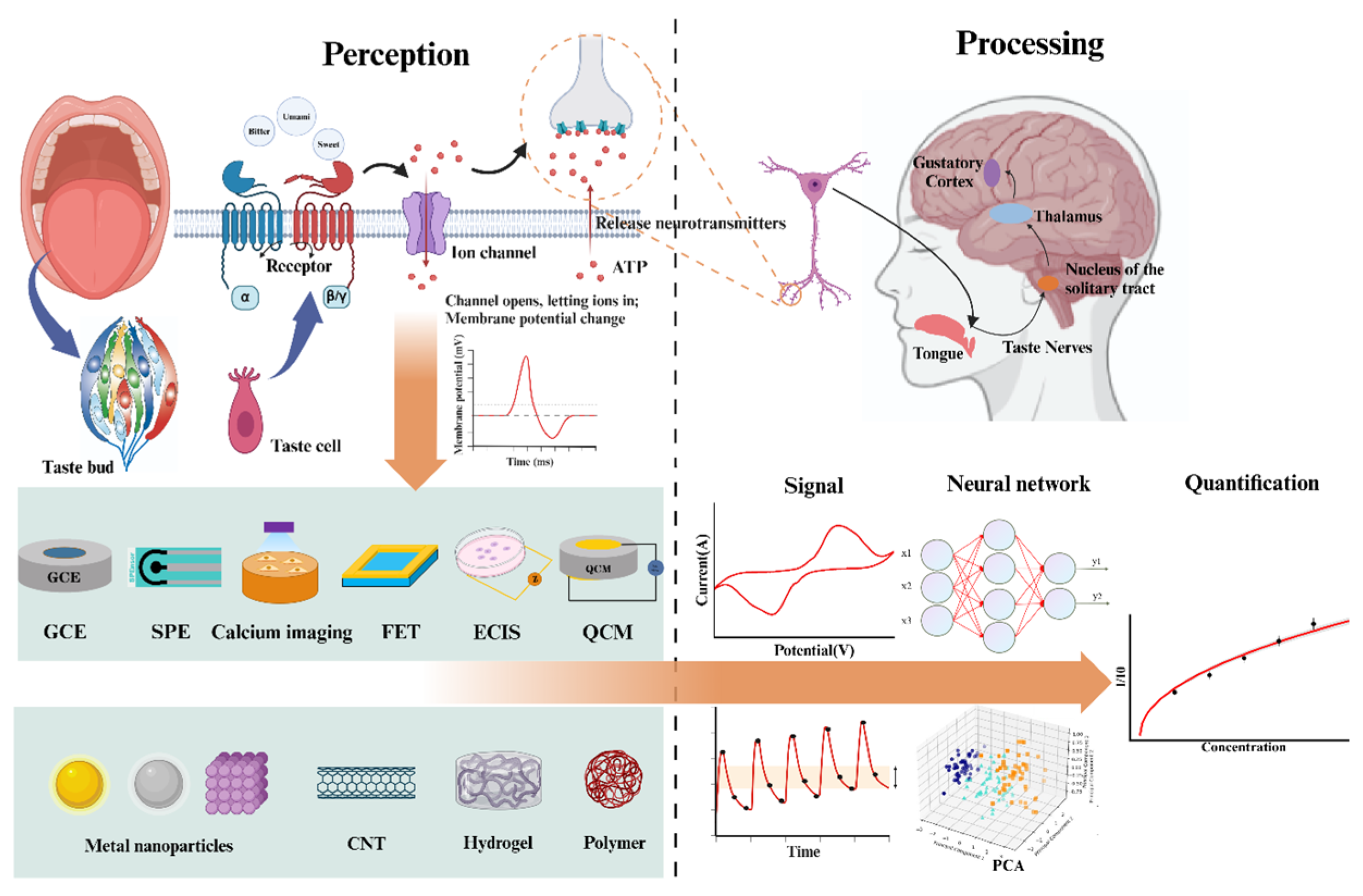
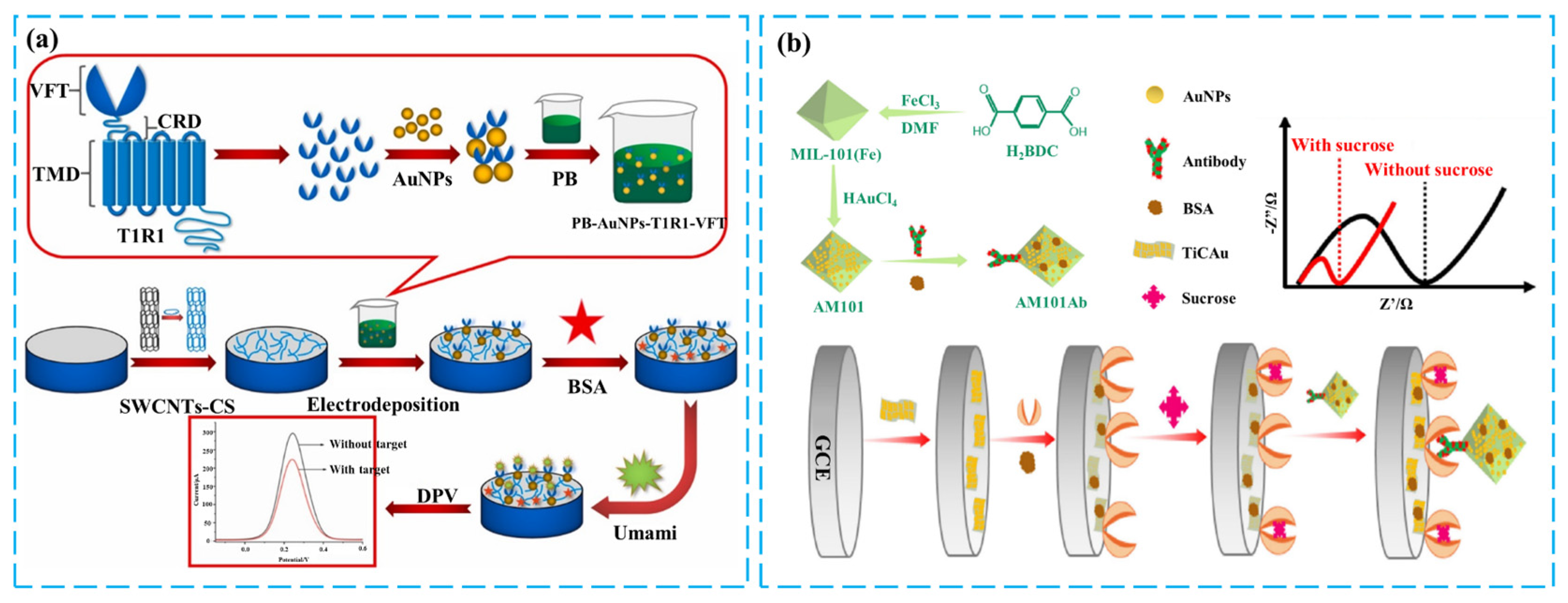
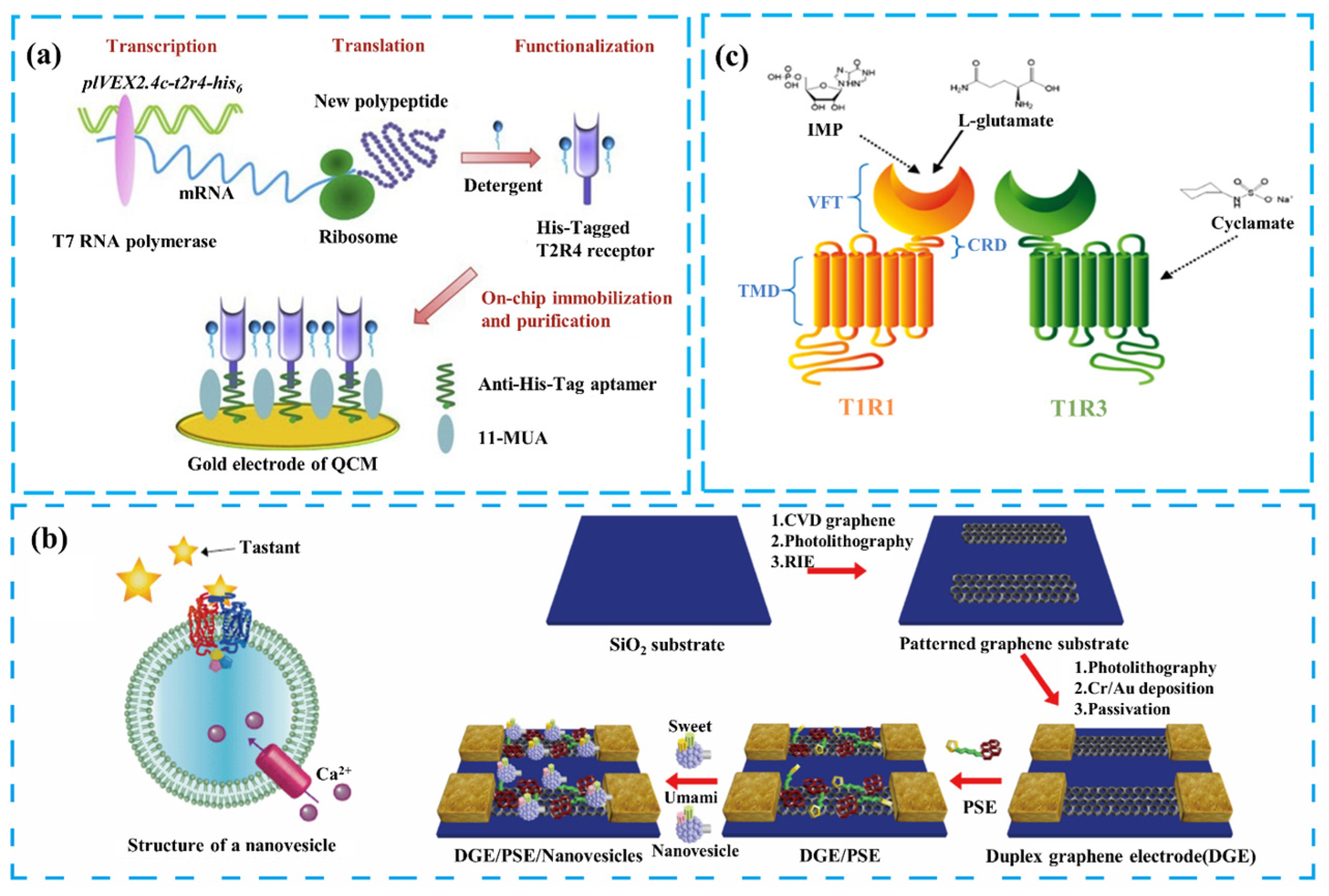
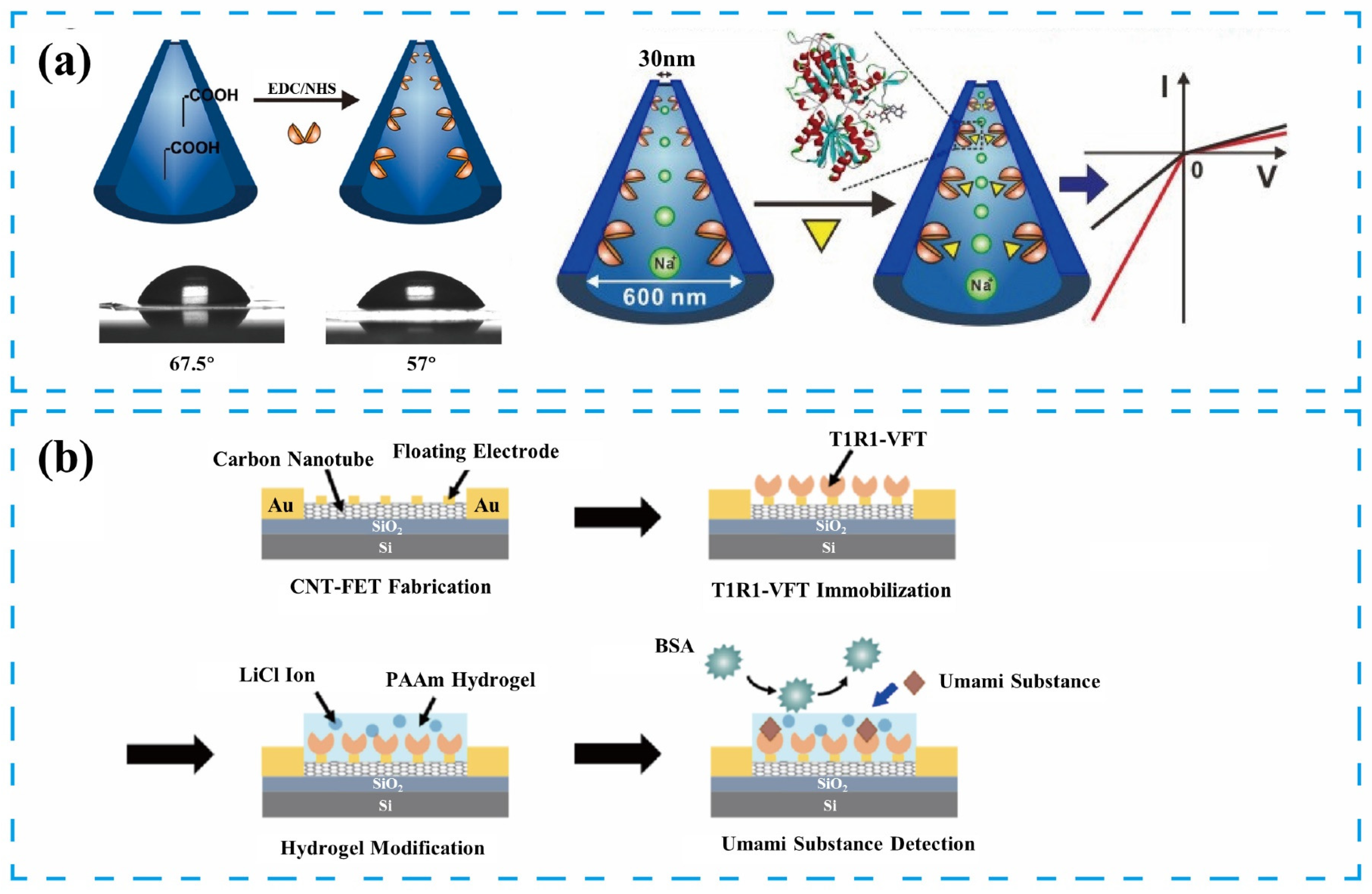
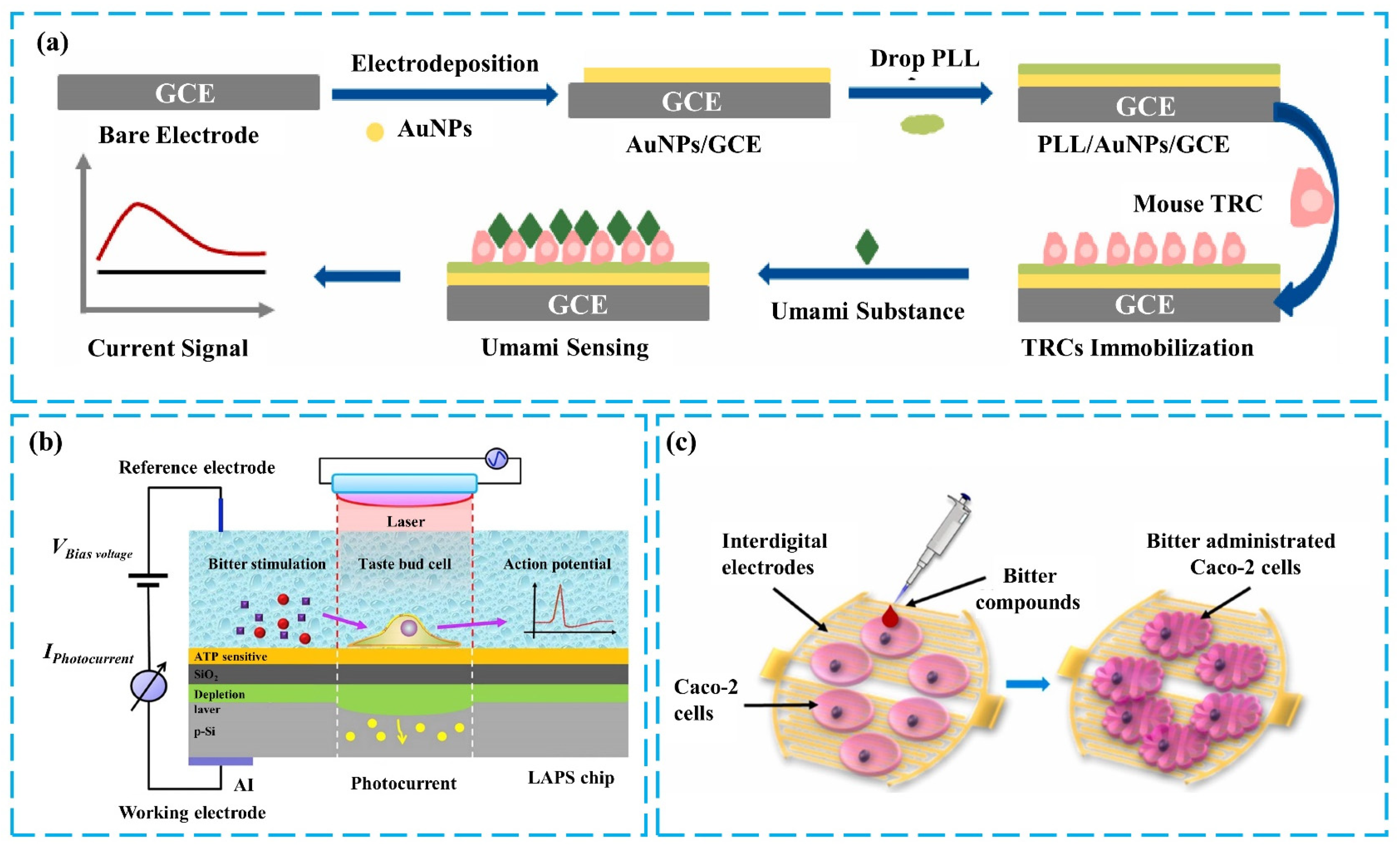

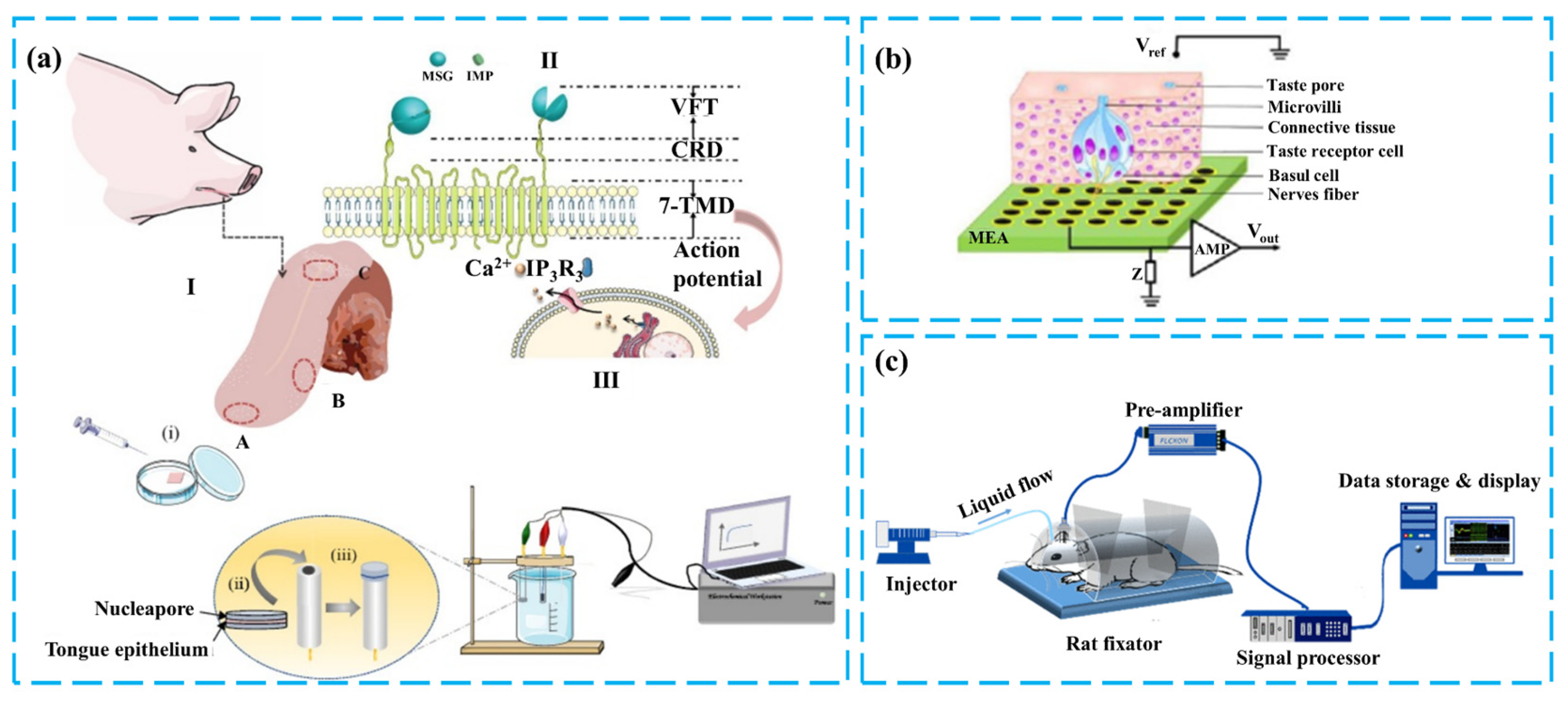
| Detection Element | Transduction Mechanisms | Target Substances | LOD | Linear Range | Ref. |
|---|---|---|---|---|---|
| T1R1-VFT/Nanochannels | EIS | IMP | 0.75 pM | 1 pM–10 μM | [46] |
| WSA | 0.59 pM | ||||
| BMP | 0.12 pM | ||||
| MSG | 0.76 pM | ||||
| T1R1-VFT/MoS2-PtPd | DPV | MSG | 0.33 pM | 1 pM–100 nM | [47] |
| IMP | 0.33 pM | 1 pM–10 μM | |||
| WSA | 3.33 pM | 10 pM–1 μM | |||
| BMP | 0.03 pM | 0.1 pM–100 nM | |||
| AmGr1/Nanovesicle | CNT-FET | Glucose | 100 fM | / | [48] |
| T2R4 | QCM | Dena | 5 nM | 10 nM–0.1 mM | [6] |
| hTAS2R16-NDs hTAS2R31-NDs | G-FETs | Salicin Saccharin | 100 fM 100 fM | 10–100 pM 100 pM–1 nM | [49] |
| T1R1-VFT/SWCNTs/PB | DPV | IMP | 0.1 pM | 0.1 pM–1 μM | [50] |
| MSG | 0.1 pM | 0.1 pM–10 nM | |||
| BMP | 0.1 pM | 0.1 pM–100 nM | |||
| WSA | 0.01 pM | 0.01 pM–10 nM | |||
| T1R1-VFT/PAAm Hydrogel | CNT-FET | MSG/IMP | 1 fM | 1 fM–10 mM | [25] |
| T1R1-VFT/AuNPs/Ti3C2 MXene | DPV | IMP | 10 pM | 10 pM–1 μM | [22] |
| MSG | 10 pM | 10 pM–1 mM | |||
| WSA | 10 pM | 10 pM–0.1 mM | |||
| BMP | 1 nM | 1 nM–0.1 mM | |||
| T1R1/AuNPs/rGO/chi/GCE | EIS | MSG | 1 fM | 10 fM–1 nM | [51] |
| IMP | 0.1 fM | 0.1 fM–0.1 pM | |||
| T1R1/GO/chi/GCE mGluR1/GO/chi/GCE mGluR4/GO/chi/GCE | CA | MSG MSG MSG | / | 1 pM–1 nM 10 fM–1 pM 1 fM–1 pM | [52] |
| Detection Element | Transducer | Target Substances | Analytical Parameters | Application | Ref. |
|---|---|---|---|---|---|
| TRCs | GCE | MSG | LOD: 1 nM Linear range: 1 nM–10 μM | taste detection | [83] |
| Taste bud cells | LAPS | ATP | Linear range: 0.1 nM–10 μM | the research of taste signal transduction | [84] |
| Caco-2/SH-SY5Y | ECIS | Bitter (Ligands salicin, PTC, Prop) | / | Relationships between bitter ligands and bitter receptors | [85] |
| Escherichia coli | ITO | Bitter (Dena) | LOD: 50 nM Linear range: 50 nM–500 nM | bitterness detection | [86] |
| Cardiomyocyte | HICB | Bitter (Dena, Diph, QN, Arbutin) | / | Bitter compound detection and classification | [87] |
| Cardiomyocyte | MEA | Dena | LOD: 3.46 µM | bitterness and umami detection | [88] |
| Diph | LOD: 2.92 μM | ||||
| MSG | LOD: 1 µM | ||||
| Organoids | TOS | Acetic acid | LOD: 1.56 mg/mL | taste detection | [89] |
| PTC | LOD: 1.52 µg/mL | ||||
| NaCl | LOD: 0.18 g/mL | ||||
| Sucrose | LOD: 0.25 g/mL | ||||
| Male mouse germ cell | CIS | Bitter (QN) | LOD: 0.125 mM | taste detection | [90] |
| Detection Element | Transducer | Target Substances | Analytical Parameters | Application | Ref. |
|---|---|---|---|---|---|
| Porcine taste bud | GCE | Umami (MSG, IMP) | Linear range: 0.1 fM–0.1 pM | the synergistic effects of MSG and IMP | [99] |
| Taste bud | GCE | Umami (MSG, IMP) | / | the distribution of umami receptors and its signal coding logic | [100] |
| Porcine taste bud | GCE | Bitter (SOA) Bitter (Dena) Bitter (Que) | LOD: 10 fM Linear range: 10 fM–1 pM LOD: 0.1 pM Linear range: 0.1 pM–10 nM LOD: 10 fM Linear range: 10 fM–1 nM | the kinetic study of bitter taste receptor sensing | [101] |
| Taste bud tissues of SD rats | GCE/Ag/AgCl electrode/platinum wire electrode | Pungency (capsaicin) Pungency (gingerol) | LOD: 0.1 pM Linear range: 0.1 pM–1 pM LOD: 1 pM Linear range: 1 pM–10 pM | pungency detection | [7] |
| GE | MEA | Sour (citric acid)/Sweet (sucrose) | / | the interaction between sweetness and sourness | [102] |
| Rat’s gustatory system | BCI | Sweet | LOD (sucrose, glucose): 0.76 mM, 0.13 mM LOD (acesulfame K, saccharin): 0.25 μM, 9.2 μM Linear range (natural sugar): 10 mM–500 mM Linear range (artificial sugar): 1 mM–50 mM | sweetness detection | [103] |
| Rat’s gustatory system | BMI | Bitter (Dena) | LOD: 0.076 μM Linear range: 1 μM–1 mM | bitterness detection | [104] |
Disclaimer/Publisher’s Note: The statements, opinions and data contained in all publications are solely those of the individual author(s) and contributor(s) and not of MDPI and/or the editor(s). MDPI and/or the editor(s) disclaim responsibility for any injury to people or property resulting from any ideas, methods, instructions or products referred to in the content. |
© 2024 by the authors. Licensee MDPI, Basel, Switzerland. This article is an open access article distributed under the terms and conditions of the Creative Commons Attribution (CC BY) license (https://creativecommons.org/licenses/by/4.0/).
Share and Cite
Liu, J.; Kuang, J.; Zhang, Y.; Chen, Y.; Liu, S.; Li, Y.; Qiao, L.; Wei, Z.; Jiang, S.; Meng, J. Research Progress of Taste Biosensors in Simulating Taste Transduction Mechanism. Chemosensors 2024, 12, 189. https://doi.org/10.3390/chemosensors12090189
Liu J, Kuang J, Zhang Y, Chen Y, Liu S, Li Y, Qiao L, Wei Z, Jiang S, Meng J. Research Progress of Taste Biosensors in Simulating Taste Transduction Mechanism. Chemosensors. 2024; 12(9):189. https://doi.org/10.3390/chemosensors12090189
Chicago/Turabian StyleLiu, Jingjing, Jiale Kuang, Yan Zhang, Yizhou Chen, Shikun Liu, Yanfeng Li, Lixin Qiao, Zhenbo Wei, Shui Jiang, and Jie Meng. 2024. "Research Progress of Taste Biosensors in Simulating Taste Transduction Mechanism" Chemosensors 12, no. 9: 189. https://doi.org/10.3390/chemosensors12090189
APA StyleLiu, J., Kuang, J., Zhang, Y., Chen, Y., Liu, S., Li, Y., Qiao, L., Wei, Z., Jiang, S., & Meng, J. (2024). Research Progress of Taste Biosensors in Simulating Taste Transduction Mechanism. Chemosensors, 12(9), 189. https://doi.org/10.3390/chemosensors12090189








